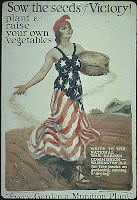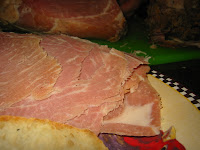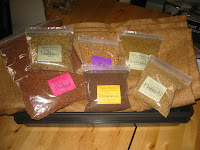There's a convergence of information in my life at the moment that's causing me to seriously question the difference between prudence and paranoia, the difference between sensible precaution and illusory guarantee. There seems to be a prevalence in our culture of "mightcouldpossibly" thinking—you know, the line of thought that goes something like "because x mightcouldpossibly happen, we need to outlaw the conditions of its possibility" regardless of the probability of x or the ramifications of the rules.
Not to put too fine a point on the issue: between government and the health care profession folks seem to believe that health can and ought to be guaranteed to the point where we're considering legislating sustainable methods of food production out of existence rather than looking to large-scale, centralized farming practices as the primary culprit of foodborne illness. More than that, we're legislating dependence on fossil fuels by privileging large-scale farming at exactly the point in time when those fuels and the systems they support have a limited life span.
Some cases in point...
Fear over potential pathogens in raw milk has prompted legislation in 22 states banning the sale of raw milk for human consumption, not only putting small dairy farms out of business but stripping the consumer of the legal ability to consume unpasteurized milk if s/he can't raise a dairy animal. If a farmer does not have the money and space to put all kinds of fancy stainless steel and concrete equipment in place for pasteurization and inspection, then she simply cannot sell dairy products. Move on, thank you very much, and leave it to the big guys.
Fear over the recent outbreak of E. coli in spinach has prompted proposed leafy green legislation in California, initiated an industry self-regulatory
marketing agreement, and spawned similar marketing agreements in other states and on
the national level. One of the significant problems with such proposals is an effort to strip wildlife buffers from agricultural crop land as potential contamination vectors, going so far as to suggest plowing under buffers to create a sterile zone around edible crops. Even next year's farm bill might get in on the act, excluding livestock as well as wildlife, according to this website:
There is discussion of having a “one mile” exclusion limit for fresh produce from “any livestock” as a possibility for the next farm bill. This would knock out a lot of small farmers and some of the major producers. Personally, I don’t think it can pass the political hurtles but it is something the vegetable industry is watching closely. It also does not address the deer, feral pigs, birds, dogs, etc. Feral pigs were implicated in the recent spinach outbreaks. Feral pig damage to crops is a major problem in California production of all sorts.
Fear over avian flu H5N1 has prompted proposed federal
NAIS (National Animal Identification System) legislation in the name of biosecurity. The USDA recommends that poultry producers "Protect poultry flocks from coming into contact with wild or migratory birds. Keep poultry away from any source of water that could have been contaminated by wild birds," arguably one-step away from mandatory confinement house operations. Not to mention the whole "backyard flock biosecurity program" and the government recommendations on keeping family pets safe from bird flu, which go so far as to state outright: "Do not feed your pets raw poultry, poultry products or eggs."
Source: www.doi.gov/issues/AI_Scenario2-QAs_wild_birds.pdfWhat all the legislation, agreements, and proposals have in common besides fear is an indirect illegalization of small, sustainable farming methods, which aren't even implicated in national food illnesses like the E. coli spinach outbreak that sickened people in at least 26 states, or the salmonella outbreak in restaurants across 21 states that served salmonella-tainted tomatoes, or the Taco Bell E. coli outbreak that sickened more than 160 people across New York, New Jersey, and other eastern states.
These illnesses were a direct result of mass production and blind consumption, yet the legislation that's proposed to prevent them is undermining one very real solution: a return to local, sustainable farming practices that are good for the animals, good for the people, good for the wildlife, and good for the earth.
Animals that aren't kept in confinement aren't nearly as likely to pass parasites and diseases. Animals that aren't kept in vast numbers aren't producing lagoons of manure that can't be sustainably reincorporated into the earth. Farms that aren't centered on a single crop/ animal don't suffer the same accumulated health risks. Joel Salatin's recent book
Everything I Want to Do Is Illegal, which grew out of
this article, is an excellent examination of the evidence that sustainable and diversified farming methods offer integrated pest and disease management, yet
government regulations consistently undermine such efforts.
Why? In large part because of fear. Of course people want to feel safe, and of course politicians want to keep their constituents safe, so they come up with measures to try to guarantee safety in an uncertain world. Who's going to vote against safety? But rather than seeing that the system itself is the problem, politicians and voters spend time and money trying to come up with band-aids like
irradiation to shore up a faulty system.
Are small farms a panacea? Are they a guarantee? Of course not. Sometimes illness can and does happen despite all reasonable efforts at protection. Sometimes wild animals get into the vegetable patch and poop. Not all crop land is perfectly level, storms happen, winds shift. But when these things happen on small, sustainable farms, the consequences are often mitigated because the animals and soil are healthy to begin with because they haven't been taxed by over-crowding, mono-cropping, and chemical applications.
The question really becomes what is "reasonable protection"? Do we confine all poultry to the bowels of a barn in order to prevent the contamination vector that wild bird contact presents? Do we plow up entire buffer zones to create wild-life-free zones around any food crops to prevent uncontrolled fecal contamination? Do we legislate diversified small farms out of existence by instituting a
one-mile buffer around marketed edible crops? How far do we go in the name of safety?
The other question we need to be asking is whether increasingly invasive and myopic legislation is any
more likely to protect folks from illness, whether it really offers the protection and guarantees it claims. And if the answer to that question is "no," then what what is the solution?
My answer to that question is for the consumer to accept—no
embrace—the dual ideas of responsibility and risk. Responsibility for knowing where and how their food is produced and for choosing wisely. Risk in the re-acquainting ourselves with the idea that we are mortal beings and that illness and death are parts of life itself whether we want them to be or not. There simply are no guarantees, and the fella that's selling them to you is just peddling snake oil.
Women throughout industrialized countries are reclaiming birth as a normal, healthy experience, freeing it from the medicalized rhetoric of fear. So too can we
all reclaim agency over our bodies through our food choices. As long as we rely on the government to do our thinking for us, we abdicate our connection to the planet, to the plants and animals that live here, and, most importantly, to our own bodies.
So much of the foodborne illness problem can be solved by knowing the food source, by washing fruits and vegetables thoroughly, and by doing more food prep at home rather than looking towards others to do it for us and then complaining when we get sick. Simply by doing these three things, the majority of foodborne illnesses
whether pathogen or parasite could be
prevented.
Instead of common sense and easy solutions, however, we set up more bureaucracy, more regulations, more rule-based, absolute thinking like never eat cookie dough, never eat runny egg yolks, and cook meat beyond all recognition. I'm betting many of us grew up tasting cookie dough. Heck, I grew up eating raw hamburger. But the industrialized food chain combined with trading risk and responsibility for guarantees has us all afraid—afraid to lick the bowl, afraid to eat traditional raw foods, afraid even to eat decently cooked meat instead of shoe leather. We're trading our palates for specious promises of protection.
Do I think we need to get rid of all regulations? No, just broad-based rules and regulations that have no bearing on small farms. Most don't even know what to do with the little guy/gal, which is why small-farm exemptions get written into legislation, but increasingly we're afraid to put in those exemptions, evidenced by states' strict stance on raw milk for instance. So, instead, we legislate the small farm out of existence despite all the national lip service paid to saving family farms.
Guidelines like
Good Agricultural Practices make sense for large operations, but much of what they advocate is inapplicable to small farms and needs to be adapted for smaller operations.
Organic standards, too, offer safety guidelines that are focused on sustainability and as such are very adaptable for small operations, though even these are increasingly tailored to
industrial-organic. Even
Certified Naturally Grown, a peer-based self-regulatory certification process that grew out of dissatisfaction with government control over "organic," is being
compromised and co-opted by government control.
Clearly, attempts at adaptation and case-by-case, situation-specific self-regulation get co-opted. Why? Fear and control. The message is that people can't be trusted—whether it's the farmer raising the food or the consumer buying it. Farmers can't be trusted to follow safe, sensible management practices or to be open to the consumer asking questions and inspecting for themselves. Consumers can't be trusted to know the facts, ask the questions, or take the simple precaution of washing their fruits and vegetables. So, the government does the thinking for us all, perpetuating the very system that causes the problems in the first place.
Rather than supporting more safety controls and regulations, let's all start thinking more...thinking more about where our food comes from, thinking more about how we prepare it, and thinking more about how to take responsibility for ourselves so we can take back control over our own bodies and our own health all the while giving back a little more to the planet and animals that support us.
 and it represents a recurring criticism of the Bush administration since 9/11. In times of crisis from 9/11 to Katrina, Bush's mantra has been to consume more, a response that has caused many folks to long for the leadership of a Kennedy or FDR.
and it represents a recurring criticism of the Bush administration since 9/11. In times of crisis from 9/11 to Katrina, Bush's mantra has been to consume more, a response that has caused many folks to long for the leadership of a Kennedy or FDR.


































